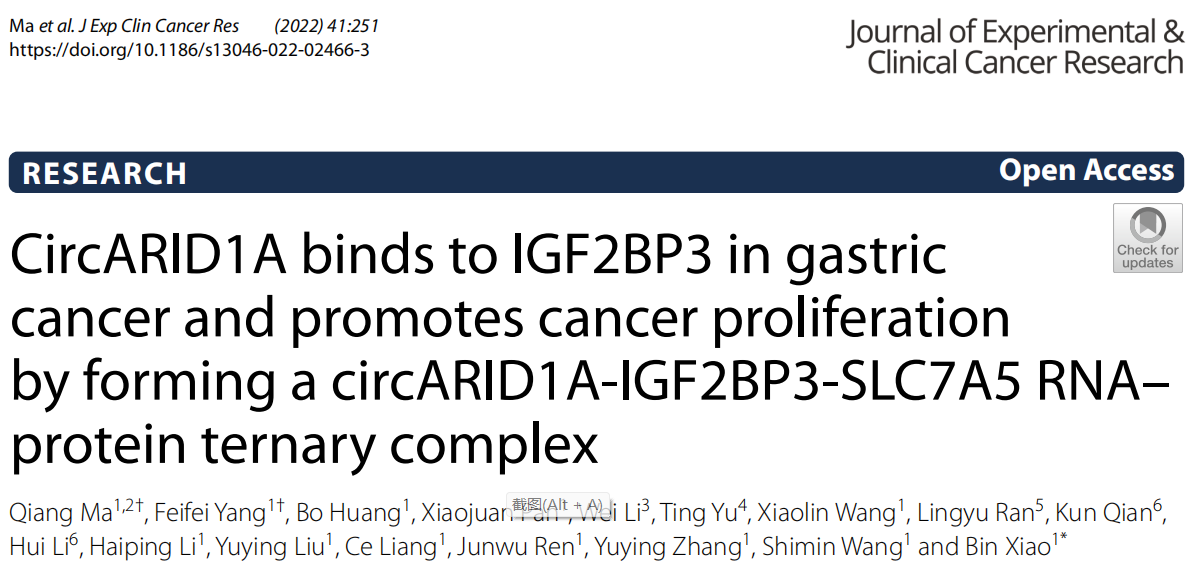-
[客户文章] 恭喜客户在J Exp Clin Cancer Res杂志发表论著,IF = 12.66
2022-11-23
BACKGROUND: Gastric cancer (GC) is one of the most common malignant tumors in China. Circular RNAs (circRNAs) are novel non-coding RNAs with important regulatory roles in cancer progression. IGF2BP3 has been found to play oncogenic roles in various cancers including GC, while the exact mechanism of IGF2BP3 is largely unknown.
METHODS: The expression of IGF2BP3 in GC was evaluated by Western Blot and bioinformatics analysis. CircRNA expression profiles were screened via IGF2BP3 RIP-seq in GC. Sanger sequencing, RNase R digestion, nucleo-plasmic separation and RNA-FISH assays were used to detect the existence and expression of circARID1A. RNA ISH assay was employed to test the expression of circARID1A in paraffin-embedded GC tissues. Moreover, the function of circARID1A on cellular proliferation was assessed by CCK-8, plate colony formation, EdU assays and GC xenograft mouse model in vivo. Furthermore, the location or binding of circARID1A, IGF2BP3 protein and SLC7A5 in GC was evaluated by RNA-FISH/IF or RNA pull-down assays.
RESULTS: We identified a novel circRNA, circARID1A, that can bind to IGF2BP3 protein. CircARID1A was significantly upregulated in GC tissues compared with noncancerous tissues and positively correlated with tumor length, tumor volume, and TNM stage. CircARID1A knockdown inhibited the proliferation of GC cells in vitro and in vivo and circARID1A played an important role in the oncogenic function of IGF2BP3. Mechanistically, circARID1A served as a scaffold to facilitate the interaction between IGF2BP3 and SLC7A5 mRNA, finally increasing SLC7A5 mRNA stability. Additionally, circARID1A was able to directly bind SLC7A5 mRNA through complementary base-pairing and then formed the circARID1A-IGF2BP3-SLC7A5 RNA-protein ternary complex and promoted the proliferation of GC via regulating AKT/mTOR pathway.
CONCLUSIONS: Altogether, our data suggest that circARID1A is involved in the function of IGF2BP3 and GC proliferation, and the circARID1A-IGF2BP3-SLC7A5 axis has the potential to serve as a novel therapeutic target for GC. -
[客户文章] 恭喜客户在Oncogene发表论著,IF = 8.76
2022-04-18
Colorectal cancer liver metastasis (CRLM) is the leading cause of colorectal cancer-related deaths and remains a clinical challenge. Enhancement of glucose uptake is involved in CRLM; however, whether long noncoding RNAs (lncRNAs) participate in these molecular events remains largely unclear. Here, we report an lncRNA, GAL (glucose transporter 1 (GLUT1) associated lncRNA), that was upregulated in CRLM tissues compared with primary colorectal cancer (CRC) tissues or matched normal tissues and was associated with the overall survival rates of CRLM patients. Functionally, GAL served as an oncogene because it promoted CRC cell migration and invasion in vitro and enhanced the ability of CRC cells to metastasize from the intestine to the liver in vivo. Mechanistically, GAL interacted with the GLUT1 protein to increase GLUT1 SUMOylation, inhibiting the effect of the ubiquitinproteasome system on the GLUT1 protein. GLUT1-knockout (−/+) repressed the GAL-mediated increase in CRC cell uptake of glucose, migrate, and invade in vitro, as well as metastasis from the intestine to the liver in vivo, and enforced expression of GLUT1 rescued GAL knockout-induced biological functions in CRC cells. Taken together, our findings demonstrated that GAL promotes CRLM by stabilizing GLUT1, suggesting that the GAL-GLUT1 complex may act as a potential therapeutic target for CRLM.


重庆高新区虎溪街道大学东路20号
重庆科技学院第39栋二楼LC06号




